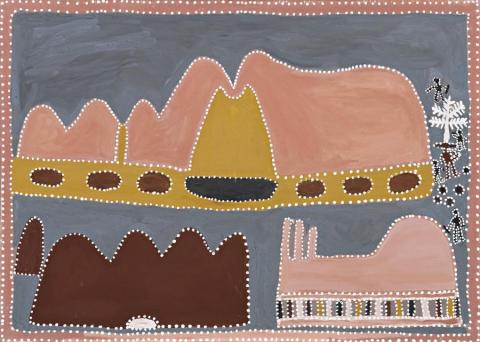WIRDIM AND DOOLNGAYIM COUNTRY, c.1996
Queenie Mckenzie Nakarra
natural earth pigments and synthetic binder on canvas
100.0 x 140.0 cm
inscribed verso: artist's name, Waringarri Arts cat. AP0744
Waringarri Aboriginal Arts, Kununurra
William Mora Galleries, Melbourne
The Collection of William and Lucy Mora, Melbourne
Queenie McKenzie, William Mora Galleries, Melbourne, 1997
This painting is accompanied by a copy of the exhibition catalogue from William Mora Galleries
Queenie McKenzie was born at old Texas Downs on the Ord River in the rugged East Kimberley. She lived there all her life until the respected long time manager retired and she along with the 'Texas Downs mob' moved to the Warmun Community at Turkey Creek, adjacent to Texas Downs station. Queenie McKenzie, therefore remained for most of her life at a locality and in a landscape that she knew intimately: 'Every rock, every hill, every water, I know that place backwards and forwards, up and down, inside out. It's my country and I got names for every place.'1 It was this singularly close relationship with her country, that prompted the artist to take up painting, but not until she had already led a full and energetic life.
During the late 1970s, her close companion Rover Thomas introduced a new dance (the Guirr Guirr). The performance was dramatised by painted boards of country which were held on the shoulders of the dancers, with only men were involved in the painting. Paddy Jaminji and Rover Thomas became well known for their art which had its inception in the dancing boards. In 1990, whilst Queenie McKenzie was camped on the bed of the Ord River at the foot of her beloved Werdim (Red Butt Mountain), she made a side elevation drawing of the mountain in the sand and declared that she too could make paintings like Rover Thomas. It was that moment that is considered the start of Queenie's career as a painter.
The natural earth pigments Queenie McKenzie employed came mostly from the hills around Turkey Creek, but as the artist became too old to dig the ochre herself, she traded with others who were fit or bought a supply through Waringarri Aboriginal Arts in Kununurra. When she discovered the technique of mixing the pigments, she was captivated by the pink effects obtained by mixing red ochre with white kaolin and shades of pink became a hallmark of her later works as this painting exemplifies.
Illustrated here is Red Butt (Wirdim) country on Texas Downs Station and Doolngayim (Argument Gap) country on Newry Station. The large yellow sand dune and hill of Doogoorenyinem sits central to and directly in front of Red Butt country. Red Butt and Doolnagayim are linked with one another through the story of Gangami. 'Throughout her childhood, Queenie grew up hearing the story of Gangami, the evil woman who hid inside a cave tucked between the red folds of the mountain known as Red Butt.'2 To the right of these hills one can see the early story of a white stockman being speared by Gija tribesmen and 'at the lower right is a striking hill with large vertical cracks of different colours.' Sitting on the left of this cracked hillside is a white circle signifying the entrance to a cave which manages to winds its way through this dark brown hill.
In her relatively short career as a painter Queenie McKenzie produced an impressive body of culturally significant work, which will no doubt continue to prove invaluable to future generations. As an artist she was an almost obsessive painter, producing canvas after canvas with frenetic energy. Some of her subjects addressed social topics such as drunkenness and massacres, but predominantly, her work was simply her country and the lore that the landscapes embraced.
1. Field, J.J. Written in the Land: The Life of Queenie McKenzie, Melbourne Books, Melbourne, 2008, p. 48
2. Ibid., p. 72
